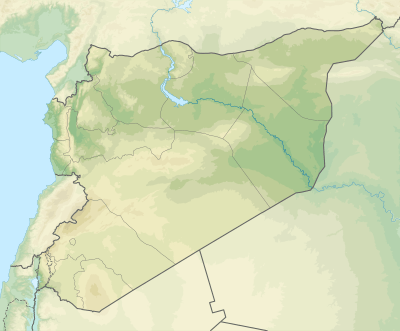Tell Aqab
Tell Aqab is an ancient Mesopotamian settlement located in northeastern Syria, occupied from the early Halaf period (c. 6000 BCE) to c. 3800 BCE. It is situated at the northern edge of the Khabur Plain near the headwaters of the Khabur tributary of the Euphrates, 6 km south-southeast of the town of Amuda in Jazira Canton.[1]:166 It is one of the few sites that contain material relating to the Halaf-Ubaid Transitional period, c. 5500–5000 BCE.
 Shown within Syria | |
| Location | Al-Hasakah Governorate, Syria |
|---|---|
| Region | Northern Mesopotamia |
| Coordinates | 37°3′29″N 40°53′44″E |
| Type | Tell |
Archaeological research
Characteristics and analysis of the pottery at Tell Aqab indicate that a large proportion of it is non-local and that there was a high level of trading activity with the nearby production centre of Chagar Bazar, some 15 km southwest of Tell Aqab.[1]:173
Microscopic examination of the Ubaid pottery of Tell Aqab show that temper had been added to the clay of all analysed vessels. Temper is not present in any of the painted Halaf pots of Tell Aqab.[2]
Marine shells have been found at Tell Aqab, linking it to further areas near the Mediterranean or Black Seas. Two specimens of Nassarius circumcinctus and one of Calliostoma zizyphinum, two sea snail species, were found in mid-to-late Halaf contexts at Tell Aqab.[1]:170 A 2003 survey of the distribution of shellfish in the "Seas of Turkey" found no C. zizyphinum nor N. circumcuntus in the Black Sea or Sea of Marmara, however both were found on the shores of the Mediterranean and Aegean Seas.[1]:173
A gradual Halaf-Ubaid Transitional phase has been identified at Tell Aqab.[3] Such a gradual transition has also been identified at other sites in Syria.[4]
References
- Marom, Nimrod; Yeshuran, Reuven; Weissbrod, Lior; Bar-Oz, Guy (2016-07-31). Bones and Identity: Zooarchaeological Approaches to Reconstructing Social and Cultural Landscapes in Southwest Asia. Oxbow Books. pp. 166–173. ISBN 9781785701757.
- Hughes, M. J. (1981). Scientific studies in ancient ceramics. British Museum. p. 32. ISBN 9780861590186.
- Davidson, T. E. (1977), Regional Variation within the Halaf Culture. Unpublished PhD thesis. Edinburgh: University of Edinburgh.
- SIMONE MÜHL and OLIVIER P. NIEUWENHUYSE (2016), Halaf and Ubaid period settlement: a view from the Central Zagros Piedmont. in: M. Iamoni (ed.), Trajectories of Complexity. Socio-economic Dynamics in Upper Mesopotamia in the Neolithic and Chalcolithic Periods, Studia Chaburensia 6, Wiesbaden: 27-56; 2016
Bibliography
- Davidson, T.E. & T. Watkins, 1981. Two seasons of excavations at Tell Aqab in the Jezirah, N.E. Syria. Iraq 43. 1-18